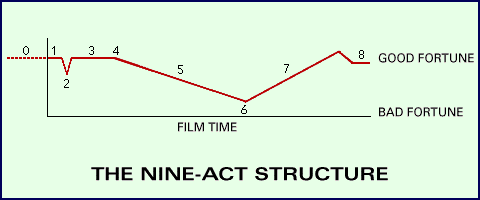NOTE: This is an overview based on work by Becky Thomas and Steve Kani, who ran a workshop at DunDraCon 2016.
TODO: introduce more about David Siegel's nine-act structure, and incorporate an overview of Hamlet's Hit Points
This was a workshop / seminar with about a dozen people. They core of it was adapting some screenwriting theories to RPGs - specifically The Nine-Act Structure by David Siegel. They also referenced Hamlet's Hit Points by Robin Laws as a useful reference.
The first principle is to generally have two goals - an initial goal, and then a twist that forces the protagonists to pursue a different goal. This was then elaborated into having a nine-act structure for the adventure and/or campaign as a whole. Each of the dozen people or so came up with a premise (a "what if"), and then a nine-act structure for turning that into an adventure or campaign. These were numbered and had a diagram for the balance between good fortune and bad fortune. The starting example was the premise "alligators in the sewers". This could lead to objectives like save someone, or clean out the sewers. It was commented that this was linear, but they suggested that the best modules get players to think that the pre-planned plot were all their own ideas. A common problem, they suggested, was losing sight of the goals and instead becoming stuck on particular ways of achieving the goals.

I started with the premise of my current Dungeons & Dragons campaign - "dragons conquer the surface of the world". Following the nine-act structure with suggestions, this lead to:
0) Someone Toils Late Into the Night: the dragon cult summons evil to the world
1) Start With an Image: what looks like a nearby flock of birds turns out to be an army of dragons on the horizon
2) Something Bad Happens: dragonborn go berserk, dragons take over
3) Meet the Hero and the Opposition: the heroes collect survivors from the town and seek shelter
4) Commitment: ally with survivors to find a safe place
5) Go for the Wrong Goal: fight their way into dungeons and establish a stronghold
6) The Reversal: several options, including find a way to save the world or find another world,
but went with "find a Hollow Earth"
7) Go for the New Goal: migrate humanity to the Hollow Earth
8) Wrap It Up: get humanity to agree ... Brave New World
This is obviously a pretty epic overarching story, and could use many adventures along the way. Noted feedback on this: A question about what place chromatic dragons have in the new world. Suggestions to keep up pressure so that finding a safe place is a relief - making the safe place more of a valid goal rather than an anticlimax.
There was also some good discussion of the difference between screenplay writing and RPG game-mastering. Allowing for different kinds of preparation - (1) plotting such as this; (2) creating background/obstacles/goals; (3) planning the implementation.
I was interested to note that they felt that for convention events, 4 hours is barely enough to have story at all. In contrast, for my son and I, we typically only play in tabletop events that are 4 hours, with some exceptions. My experience has been that longer events often don't have more story, but rather have long fight scenes, puzzles, and other sidetracks.